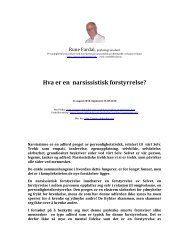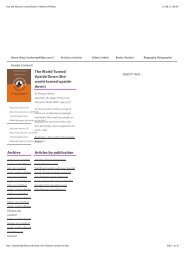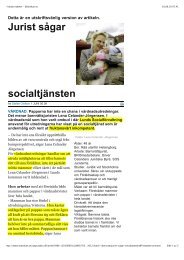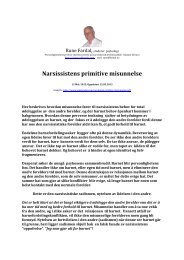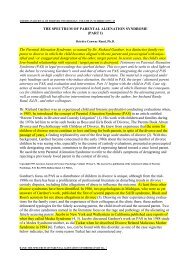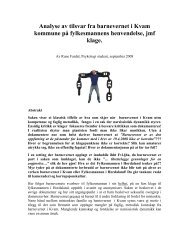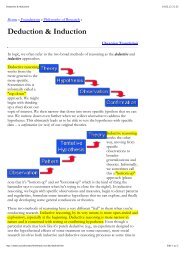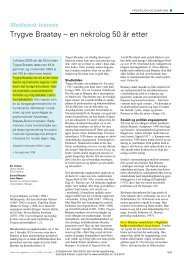The origins of narcissism and narcissistic personality disorder a
The origins of narcissism and narcissistic personality disorder a
The origins of narcissism and narcissistic personality disorder a
You also want an ePaper? Increase the reach of your titles
YUMPU automatically turns print PDFs into web optimized ePapers that Google loves.
44 JOHN S. AUERBACH<br />
studies have addressed theoretical questions, primarily those underlying<br />
the Kernberg-Kohut (or conflict-deficit) debate in <strong>narcissism</strong>. Although<br />
intriguing, the results <strong>of</strong> these studies are also contradictory.<br />
Some findings support Kernberg’s view that <strong>narcissistic</strong> <strong>personality</strong><br />
<strong>disorder</strong> is rooted in conflict <strong>and</strong> in the use <strong>of</strong> gr<strong>and</strong>iose defenses<br />
against issues <strong>of</strong> aggression, envy, <strong>and</strong> dependence (Glassman, 198813;<br />
Harder, 1984; Raskin & Novacek, 1991; Raskin, Novacek, & Hogan,<br />
1991a, 1991b; Shulman & Ferguson, 1988b). Other results support the<br />
Kohutian position that this form <strong>of</strong> psychopathology involves a developmental<br />
deficit in needs for mirroring <strong>and</strong> idealization (Glassman,<br />
1988a; Lapan & Patton, 1986; Patton, Connor, & Scott, 1982; Payne,<br />
Robbins, & Dougherty, 1991; Robbins, 1989; Robbins & Patton, 1985).<br />
Finally, some delineate two forms <strong>of</strong> <strong>narcissistic</strong> character pathology<br />
(Richman & Flaherty, 1988; Wink, 1991).<br />
Conflicting results like these constitute a major reason why psychoanalysis<br />
has so long devalued or ignored attempts to test its theories<br />
empirically. It is easier, it seems, to retreat to the consulting room,<br />
where one’s patients always seem to confirm one’s favored theories,<br />
regardless <strong>of</strong> one’s therapeutic orientation (Grunbaum, 1984; Masling<br />
& Cohen, 1987), than to cope with the ambiguity <strong>of</strong> inconsistent data<br />
or discrepant findings. And yet a detailed critique <strong>of</strong> most existing<br />
empirical investigations <strong>of</strong> <strong>narcissism</strong> <strong>and</strong> <strong>narcissistic</strong> <strong>personality</strong> <strong>disorder</strong><br />
no doubt would reveal such efforts to be inadequate in capturing<br />
the complex phenomena that clinicians think about when they encounter<br />
<strong>and</strong> treat <strong>narcissistic</strong> disturbances.<br />
Although studies that test theories <strong>of</strong> <strong>narcissism</strong> <strong>and</strong> <strong>narcissistic</strong> <strong>personality</strong><br />
<strong>disorder</strong> in a more ecologically or externally valid manner are<br />
certainly needed, more <strong>and</strong> better research will not by itself resolve<br />
dilemmas regarding these topics. Adler (1986) has cited three reasons<br />
why the Kernberg-Kohut controversy continues unabated: (a) paradigm<br />
clash, or the ability <strong>of</strong> clinicians from rival schools to reinterpret<br />
Harder (1979); McCann (1989); Millon (1982); Morey, Blashfield, Webb, <strong>and</strong><br />
Jewel1 (1988); Morey, Waugh, <strong>and</strong> Blashfield (1985); Mullins <strong>and</strong> Kopelman<br />
(1988); Raskin <strong>and</strong> Hall (1979); Raskin <strong>and</strong> Novacek (1989); Raskin <strong>and</strong> Shaw<br />
(1988); Raskin <strong>and</strong> Terry (1988); Ronningstam (1988); Ronningstam <strong>and</strong> Gunderson<br />
(1988, 1989, 1990); Shulman <strong>and</strong> Ferguson (1988a); Shulman, Mc-<br />
Carthy, <strong>and</strong> Ferguson (1988); Solomon (1982); Stone (1989); Wink <strong>and</strong> Gough<br />
(1990).




